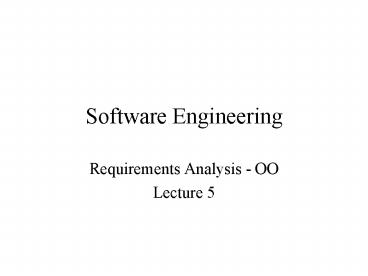Software Engineering - PowerPoint PPT Presentation
1 / 23
Title:
Software Engineering
Description:
UML 'Views' User model view. Structural model view. Behavioral model view. Implementation model view ... Environment model view. Domain analysis. Creating a ... – PowerPoint PPT presentation
Number of Views:11
Avg rating:3.0/5.0
Title: Software Engineering
1
Software Engineering
- Requirements Analysis - OO
- Lecture 5
2
Text
- This lecture covers material from Chapter 4
- However, I assume that you are comfortable with
OO concepts! - A problem I dont have last years projects that
used an OO approach - we are stuck with poor examples.
3
OO/Structured differences
- Fichman Kemerer Process oriented methodologies
focus attention away from the inherent properties
of objects during the modeling process - encapsulation
- classification of objects
- inheritance
- In SA - data is considered separately from
processes which transform it -- top down
development, and end to end processing sequences
4
Several OO approaches
- Booch method -- Behavior/operational emphasis --
identify classes objects, understand their
behavior relationships, and refine - Rumbaugh method -- Object Modeling Technique
(OMT) -- 3 models - object model objects, classes, their
relationships and hierarchies
5
OO approaches
- Rumbaugh
- dynamic model object system behavior, with a
data emphasis - functional model similar to DFD
- Jacobson method -- Object Oriented Software
Engineering (OOSE) -- emphasis on use cases - requirements
- analysis model
6
OO approaches
- Coad Yourdon
- Identify Objects
- Define a generalization/specification structure
- Define a whole/part structure
- Identify subjects
- Define attributes
- Define services
- UML
7
UML Views
- User model view
- Structural model view
- Behavioral model view
- Implementation model view
- Environment model view
8
Domain analysis
- Creating a library of reusable classes/components
9
Components of OO analysis
- Static view of classes
- Static view of attributes
- Static view of relationships
- Static view of behaviors
- Dynamic view of communication
- Dynamic view of control and time
10
Steps of OOA
- Step I Use cases
- Step II CRC cards
- class types
- characteristics
- Step III Defining Structures hierarchies
packages
11
(No Transcript)
12
(No Transcript)
13
(No Transcript)
14
(No Transcript)
15
(No Transcript)
16
Steps of OOA
- Step IV Object-relationship model
- connect classes that are related (CRC cards help)
- use verbs to connect classes
- somewhat similar to ERD
- do not use modality
17
(No Transcript)
18
Steps of OOA
- Step V Object-Behavior model
- use use-cases to identify events
- identify the events that drive the interaction
sequence and to understand how they relate to
objects
19
Steps of OOA
- Step V Object-Behavior model
- create an event trace for each use case
- create an event-flow diagram for the system
20
Event Trace
21
Event Flow Diagram
22
Steps of OOA
- Step V Object-Behavior model
- Build a state transition diagram (like the
structured approach) - review
23
(No Transcript)































